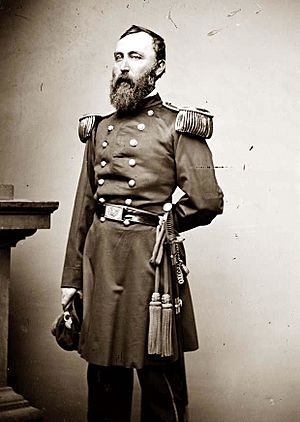Jacob B. Sweitzer facts for kids
Quick facts for kids
Jacob Bowman Sweitzer
|
|
|---|---|
 |
|
| Born | July 4, 1821 Brownsville, Pennsylvania |
| Died | November 7, 1888 (aged 67) Pittsburgh, Pennsylvania |
| Place of burial |
Allegheny Cemetery, Pittsburgh, Pennsylvania
|
| Allegiance | United States of America Union |
| Service/ |
United States Army Union Army |
| Years of service | 1861-1864 |
| Rank | |
| Commands held | 62nd Pennsylvania Infantry Sweitzer's Brigade, V Corps |
| Battles/wars | American Civil War |
| Other work | Attorney |
Jacob Bowman Sweitzer (born July 4, 1821 – died November 7, 1888) was a Pennsylvania lawyer and soldier. He led groups of soldiers called a regiment and later a brigade in the Army of the Potomac. This was during the American Civil War.
Sweitzer and his men played a big part in the 1863 Battle of Gettysburg. They helped strengthen and hold the Union defensive line. This happened on the second day of the battle.
Contents
Early Life and Education
Jacob Bowman Sweitzer was born on July 4, 1821. His birthplace was Brownsville, a town in Fayette County, Pennsylvania. His parents were Henry Sweitzer and Ann Elliott Bowman. His family had come to America from Germany.
Jacob had a younger brother named Nelson Bowman Sweitzer. Nelson also became an army officer later in his life. Jacob went to Jefferson College and finished his studies there in 1843. After college, he studied law and became a lawyer. He then started his own legal practice.
Joining the Civil War
When the American Civil War began, Jacob Sweitzer joined the Union Army. On July 4, 1861, he became a Major in the 62nd Pennsylvania Infantry regiment. He was promoted to lieutenant colonel on November 17, 1861.
Later, on June 27, 1862, he became a Colonel. Colonel Sweitzer and his regiment fought in the Peninsula Campaign. During the Seven Days Battles, he was wounded and captured at the Battle of Gaines' Mill. He was later released on August 15, 1862.
Leading Soldiers
After being released, Colonel Sweitzer led his regiment again. They fought in the Second Battle of Bull Run and the Battle of Antietam. His regiment was part of a larger group called a brigade, led by Brigadier General Charles Griffin.
When General Griffin took command of a larger group (a division), Sweitzer temporarily led Griffin's brigade. This included leading them at the Battle of Fredericksburg. After that, he went back to leading his own regiment. He later took command of the brigade again at the Battle of Chancellorsville.
The Battle of Gettysburg
At the Battle of Gettysburg, Sweitzer's V Corps arrived on July 2, 1863. They had marched a long way from Unionville, Maryland. His division was sent to help the III Corps on the left side of the Union line.
Sweitzer's brigade and another brigade went into action. They were positioned between two important areas called the Wheatfield and the Peach Orchard. Their position was difficult to hold because of how they were set up. After facing strong attacks from the Confederate army, their general decided they needed to pull back.
Fighting in the Wheatfield
Even after pulling back, Sweitzer's command was sent back into the fight. They entered the Wheatfield, where the fighting was very intense. However, Confederate soldiers attacked them from the side, causing many losses. Colonel Harrison Jeffords of the 4th Michigan Infantry was killed trying to protect his regiment's flag.
Sweitzer's brigade then pulled back towards Little Round Top. They stayed in that area for the rest of the battle. His brigade had only three regiments fighting that day. He reported that his regiments lost 466 out of 1,010 soldiers. This shows how fierce the fighting was.
After Gettysburg, Sweitzer continued to lead his brigade. They took part in the Bristoe Campaign and the Mine Run Campaign in the fall of 1863.
Later War Service
Before Lieutenant General Ulysses S. Grant's Overland Campaign, the Union Army was reorganized. Sweitzer kept his command of a brigade in Griffin's division. His brigade also took in soldiers from another group.
Sweitzer led his brigade in several major battles. These included the Battle of the Wilderness and the Battle of Spotsylvania. He showed great bravery at the Battle of North Anna. There, he held an exposed position against a Confederate attack. He also commanded his troops at the Battle of Cold Harbor and during the early parts of the Siege of Petersburg.
Sweitzer left the army with his regiment on July 13, 1864. He received a special promotion called a brevet promotion. This made him a brigadier general for his excellent service during the war. This promotion was given on March 13, 1865.
Life After the War
After leaving the army, Jacob Sweitzer moved to Pittsburgh, Pennsylvania. He went back to working as a lawyer there. Jacob Sweitzer passed away on November 7, 1888. He was buried at Allegheny Cemetery in Pittsburgh.

